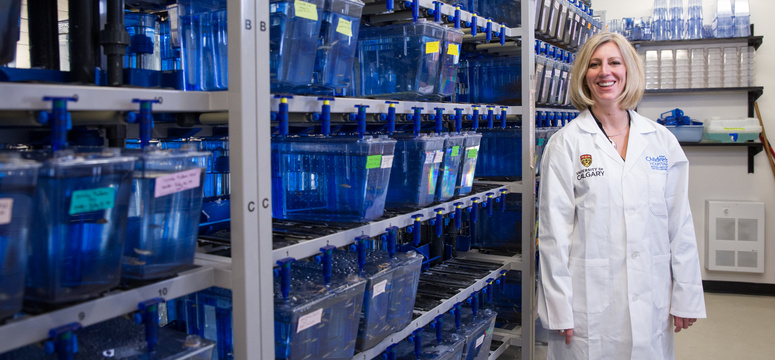Support strong Canadian climate journalism for 2025
It’s a case of conflicting studies that could have serious consequences for the health of Canadians.
Scientists agree that BPA is harmful, but regulatory agencies such as Health Canada contend the chemical is benign. So who’s right?
A lot of studies have been carried out on the impact of Bisphenol A - better known as BPA - on human health. One researcher estimates the reports number in the “tens of thousands” worldwide.
BPA is an epoxy resin used as linings in food cans to prevent corrosion and preserve food quality. It's also used in plastic reusable water bottles, plastic food containers and in thermal printed receipts.
But it is also a class of hormone-disrupting chemical, serious enough that Health Canada and the U.S. Food and Drug Administration banned their use in liquid infant formula products, baby bottles and sippy cups.
So if it's dangerous enough to ban from baby bottles, why is it allowed in cans? In an email to National Observer Health Canada simply skirts the scientific concerns: “At the current levels found in the Canadian food supply, Bisphenol A (BPA) exposure from food packaging does not pose a health risk to any segment of the Canadian population.”
Environmental Defence says BPA is linked to cancer
Maggie MacDonald, who manages a program at Toronto-based Environmental Defence that scrutinizes toxic substances in consumer products, disagrees.
MacDonald says BPA is suspected of being linked to breast cancer as well as to prostate cancer.
A recent Environmental Defence report notes the chemical is an endocrine disrupter that mimics hormones in the human body such as estrogen, and interferes with the cell hormone signalling that determines our development and affects how our reproductive, metabolic and immune systems function.
The same report also draws a link between low levels of BPA to increased risk of infertility, early puberty in females, type-2 diabetes, obesity, asthma, and impaired neurological development in children.
The chemical is so prevalent in consumer products that according to Statistics Canada’s Canadian Health Measures Survey 95 per cent of Canadians between the ages of three and 79 have BPA in their bodies.
A new study from Stanford and John Hopkins Universities in June 2016 found that higher urinary BPA concentrations were directly linked to consumption of canned food; the more canned food people ate, the higher the levels of BPA in their bodies.

“It seems like Health Canada’s response to the BPA stuff has been to reassure people they’ve already taken care of this issue with existing regulations and continue to monitor the existing science,” MacDonald says.
Health Canada and CFIA produced conflicting studies
But MacDonald contends some of the federal government’s science is suspect. At the very least, two federal government agencies - Health Canada and the Canadian Food Inspection Agency - failed to coordinate their studies on BPA - both of which arrived at startlingly different conclusions.
Health Canada published a report in 2010 that said the majority of food cans and food products did have detectable levels of BPA.
Two years later, in 2012, the Canadian Food Inspection Agency produced a study that said 98.5 per cent of food samples from cans purchased in Canada had no detectable levels of BPA.
Good news, right? Well, not really.
It turns out the second study had a much higher detection limit set. The detection limit is where instruments are set when testing for the presence of a substance in a laboratory. In the instance of testing for a chemical such as, say, BPA, a scientist can set the detection limits so that it will pick up very low levels of BPA or only the very highest level of the chemical.
The Health Canada study in 2010 was set to a detection limit according to European standards. This European baseline has become the international standard for a lot of studies into the chemical.
The Food Inspection Agency study’s limits were set so high that only the sample cans that exceeded the maximum amount would have been detectable under that study, MacDonald says.
Health Canada and CFIA disregard questions
The Canadian Food Inspection Agency did not respond to National Observer’s questions about the study.
Health Canada disregarded National Observer’s questions about the two conflicting studies, but did reply in an email that the department conducts periodic reviews of BPA as new information related to its toxicity or potential exposure comes available.
The agency said recently it conducted two studies into BPA, one comparing concentrations in total diet samples, including from canned foods, from 2008 to 2012. The other examined BPA levels in canned fish samples.
“While some BPA was detected in all the canned food products, the position of Health Canada, the United States Food and Drug Administration (US FDA) and the European Food Safety Authority (EFSA) is that current exposures to BPA do not represent a health concern,” a departmental spokesperson wrote.
At a minimum, MacDonald says this is a matter of two federal government agencies not properly coordinating with each other. But she has a greater worry.
“Other concerns come to mind as well,” MacDonald says, “because this is information that is used to reassure the Canadian public that BPA in food wasn’t a problem. But if the study wasn’t done to international standards, then I don’t think those results should have been used to reassure the Canadian public.”

Deborah Kurrasch, an assistant professor in the Department of Medical Genetics at the University of Calgary, has studied the effects of BPA on zebrafish.
Her study in the Proceedings of the National Academy of Sciences in 2015 showed evidence that BPA causes alterations in brain development leading to hyperactivity in zebrafish.
Kurrasch said at the time that the findings supported other studies suggesting pregnant women should try to limit their exposure to BPA, and that the evidence supported removing all BPA and structurally similar chemicals from consumer products.
“The question is, how can the scientific community be saying one thing and Health Canada the other?” Kurrrasch said in an interview with National Observer.
She points to a couple of reasons. Kurrasch says it’s hard to show that people have developed different sorts of diseases from BPA exposure. Therefore, if health agencies are going to rule to drop the chemical or ban it altogether, they need to have strong evidence, which is hard to get.
“We can get it in animal models, and I think that’s why the scientific community is much more comfortable declaring an issue with BPA and health. I think Health Canada and the other regulatory agencies have a higher standard.”
Kurrasch says tens of thousands of studies available on BPA
The other issue, Kurrasch says, is a huge body of literature exists pointing to some sort of effect from BPA. She says literally tens of thousands of papers on the subject exist.
The breadth of the research is impressive, according to Kurrasch, but it’s hard to link all the individual studies together.
“You have to take them as a collective. I think this is where scientists come down very strongly: collectively this is pointing at some sort of effect.”
While Health Canada and other regulatory agencies disregard this vast body of research, the food companies themselves appear to be taking the issue seriously. Both Campbell and Dole say they are phasing out BPA linings in cans.
Food industry lobby group goes silent on BPA
But even as the two food giants respond to concern over the chemical, the Food & Consumer Products of Canada (FCPC) association still backs Health Canada.
FCPC did not return National Observer’s calls, but earlier this year in response to a large study by Environmental Defence, the Breast Cancer Fund and others issued over BPA in cans, the association called Canada’s current regulatory system for BPA one of the most stringent in the world.
“BPA is also a highly tested substance and at current levels of exposure governments globally continue to recognize its current use in can linings as safe. We rely on the sound science conducted at Health Canada to inform our decisions on the selection of safe materials,” Susan Abel, FCPC’s vice president of safety and compliance said in a statement.
But MacDonald and Environmental Defence are adamant. They’ve called for a ban of BPA from all food contact materials in Canada.
MacDonald notes BPA is a chemical already on Environment Canada’s toxic schedule one listing, the list of substances found toxic under Canadian law and subject to some regulations.
“But the problem with the current regulatory picture is that it’s not enough to protect the general population and children from the full range of effects of BPA.”






Comments
It always surprises me how agencies in this case health Canada are always so ready to accept certain situations even though they know there is definitely a negative. As the protector of Canadians this federal agency should be taking a zero tolerance on toxics- that Canadians ingest.
When it comes to discrepancies between scientific research findings and standards set by Health Canada, one can be certain that Health Canada standards are influenced by the industry affected by the regulations.
Furthermore, when Canada sets standards they tend to be voluntary which is often the same as having no standards at all.
It is only when citizens become politically aware and insist on full transparency in the setting and enforcement of standards that Canadian consumers will have a chance to understand what they’re actually buying.